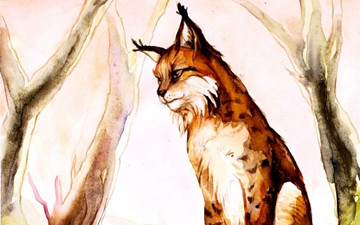The Eurasian lynx is the biggest of the lynxes, ranging in length from 81 to 129 centimetres (32 to 51 in) and standing about 70 centimetres (28 in) at the shoulder. Males usually weigh from 18 to 30 kilograms (40 to 66 lb) and females weigh 18 kilograms (40 lb) on average.[3] It has powerful legs, with large webbed and furred paws that act like snowshoes. It also possesses a short “bobbed” tail with an all-black tip, black tufts of hair on its ears, and a long grey-and-white ruff.
During the summer, the Eurasian lynx has a relatively short, reddish or brown coat, which tends to be more brightly coloured in animals living at the southern end of its range. In winter, however, this is replaced by a much thicker coat of silky fur that varies from silver-grey to greyish-brown. The underparts of the animal, including the neck and chin, are white at all times of the year. The fur is almost always marked with black spots, although the number and pattern of these is highly variable. Some animals also possess dark brown stripes on the forehead and back. Although spots tend to be more numerous in animals from southern populations, Eurasian lynx with heavily spotted fur may exist close to others with plain fur.[4]
Eurasian lynx make a range of sounds, but these are generally quiet outside of the breeding season. They have been observed to mew, hiss, growl, and purr, and, like domestic cats, will “chatter” at prey that is just out of reach. Mating calls are much louder, consisting of deep growls in the male, and loud “meow”-like sounds in the female.[4]
Eurasian lynx are secretive, and because the sounds it makes are very quiet and seldom heard, the presence of the species in an area may go unnoticed for years. Remnants of prey or tracks on snow are usually observed long before the animal is seen.
(From Wikipedia.org, July 11 2010)
– – –




